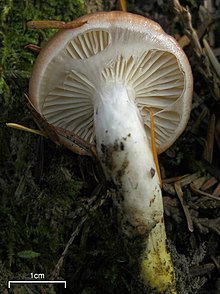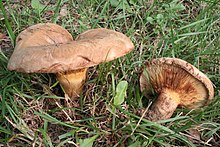Boletales: Difference between revisions
Report bugs here. |
Rescuing 1 sources and tagging 0 as dead. #IABot (v1.6.1) (Feminist) |
||
| Line 80: | Line 80: | ||
<ref name="Hennings 1897">{{cite journal |author=Hennings P. |title=Fungi camerunenses II |journal=Botanische Jahrbücher für Systematik Pflanzengeschichte und Pflanzengeographie |year=1897 |volume=23 |pages=537–58 |language=German}}</ref> |
<ref name="Hennings 1897">{{cite journal |author=Hennings P. |title=Fungi camerunenses II |journal=Botanische Jahrbücher für Systematik Pflanzengeschichte und Pflanzengeographie |year=1897 |volume=23 |pages=537–58 |language=German}}</ref> |
||
<ref name="McNabb">[http://www.rsnz.org/publish/nzjb/1967/37.php McNabb R.F.R. (1967) The Strobilomycetaceae of New Zealand] gives a history of this smaller family.</ref> |
<ref name="McNabb">[http://www.rsnz.org/publish/nzjb/1967/37.php McNabb R.F.R. (1967) The Strobilomycetaceae of New Zealand] {{webarchive|url=https://web.archive.org/web/20050530095701/http://www.rsnz.org/publish/nzjb/1967/37.php |date=2005-05-30 }} gives a history of this smaller family.</ref> |
||
<ref name=may07>May, T.W., Milne, J., Wood, A.E., Shingles, S., Jones, R.H. & Neish, P. (2007). Interactive Catalogue of Australian Fungi. Version 2.0. Australian Biological Resources Study, Canberra / Royal Botanic Gardens Melbourne. {{cite web |url=http://www.rbg.vic.gov.au/fungi/cat/ |title=Archived copy |accessdate=2007-02-04 |deadurl=yes |archiveurl=https://web.archive.org/web/20040815132839/http://www.rbg.vic.gov.au/fungi/cat/ |archivedate=2004-08-15 |df= }} [accessed 05 Feb 2007].</ref> |
<ref name=may07>May, T.W., Milne, J., Wood, A.E., Shingles, S., Jones, R.H. & Neish, P. (2007). Interactive Catalogue of Australian Fungi. Version 2.0. Australian Biological Resources Study, Canberra / Royal Botanic Gardens Melbourne. {{cite web |url=http://www.rbg.vic.gov.au/fungi/cat/ |title=Archived copy |accessdate=2007-02-04 |deadurl=yes |archiveurl=https://web.archive.org/web/20040815132839/http://www.rbg.vic.gov.au/fungi/cat/ |archivedate=2004-08-15 |df= }} [accessed 05 Feb 2007].</ref> |
||
Revision as of 10:10, 22 December 2017
| Boletales | |
|---|---|

| |
| Boletus edulis | |
| Scientific classification | |
| Kingdom: | Fungi |
| Division: | |
| Class: | |
| Subclass: | |
| Order: | Boletales E.-J.Gilbert (1931)[1] |
| Families | |
| |
The Boletales are an order of
Taxonomy

The order Boletales originally was erected to describe boletes, but based on
Phylogenetic analyses shows the
In some older classification systems, a part of the family Boletaceae was separated to form the family Strobilomycetaceae.[5][6] However, more recent molecular genetics studies have found it to be an unnatural grouping.[7] According to the 2008 (10th) edition of the Dictionary of the Fungi, the Boletales comprise 17 families, 96 genera, and 1316 species.[8]
Ecology
The Boletales are largely
Edibility and identification

Boletes are usually identified by having a sponge-like surface under the cap, instead of the usual gills. They occur in a variety of colours, such as red, white, brown and gray. Many of the inedible boletes are either white or red, and these should be avoided during picking.
The genus Boletus contains many edible species, most notably,
The
Genera incertae sedis
There are several genera classified in the Boletales that are i) poorly known, ii) have not been subjected to DNA analysis, or iii) if analysed phylogenetically do not group with as yet named or identified families, and have not been assigned to a specific family (i.e., incertae sedis with respect to familial placement). These include:
See also
Boletales.
- Bolete eater
- List of Boletus species
References
- ^ Gilbert J.-E. (1931). Les Livres du Mycologue Tome I-IV, Tom. III: Les Bolets (in French). Paris: Le François. p. 83.
- PMID 17486973.
- PMID 21156480.
- ^ Besl H, Bresinsky A. (1997). Chemosystematics of Suillaceae and Gomphidiaceae (suborder Suillineae). Plant Systematics and Evolution 206:223–242. (abstract)
- ^ McNabb R.F.R. (1967) The Strobilomycetaceae of New Zealand Archived 2005-05-30 at the Wayback Machine gives a history of this smaller family.
- ^ May, T.W., Milne, J., Wood, A.E., Shingles, S., Jones, R.H. & Neish, P. (2007). Interactive Catalogue of Australian Fungi. Version 2.0. Australian Biological Resources Study, Canberra / Royal Botanic Gardens Melbourne. "Archived copy". Archived from the original on 2004-08-15. Retrieved 2007-02-04.
{{cite web}}: Unknown parameter|deadurl=ignored (|url-status=suggested) (help)CS1 maint: archived copy as title (link) [accessed 05 Feb 2007]. - .
- ISBN 0-85199-826-7.
- ISBN 0-7307-5528-2.
- ^ Hennings P. (1897). "Fungi camerunenses II". Botanische Jahrbücher für Systematik Pflanzengeschichte und Pflanzengeographie (in German). 23: 537–58.
- JSTOR 3758712.
- ^ States JS, Fogel R (1999). "Marthanella nidulosa, sp. et gen. nov., a hypogeous basidiomycete from northern Arizona, U.S.A." Mycotaxon. 71: 423–30.
- ^ Patouillard NT. (1900). "Champignons de la Guadeloupe". Bulletin de la Société Mycologique de France (in French). 16: 175–88.
External links
- "The Boletes ('Boletales')" by Michael Kuo, MushroomExpert.Com, March 2005
- The Boletes of Michigan by Alexander H. Smith and Harry D. Thiers, 1971. (Full text monograph)
